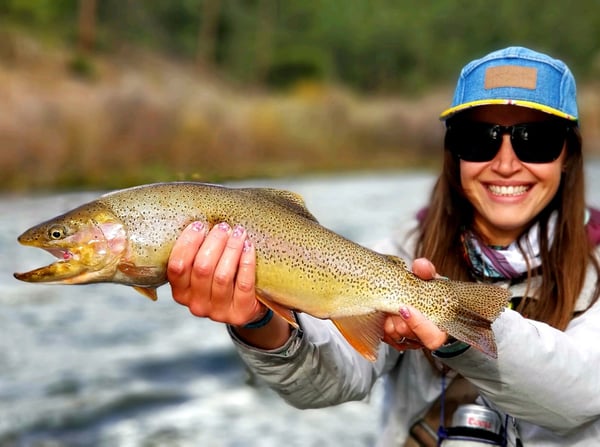Deckers is the most recognizable stretch of the South Platte River near Denver, and winter strips away the crowds while leaving the fish. When flows are stable and pressure drops, Deckers fly fishing becomes a technical but rewarding tailwater that consistently produces trout for anglers willing to slow down and fish clean. If you want dependable fly fishing near Denver in winter, Deckers remains a top tier option.
-1.png?width=1200&height=675&name=South%20Platte%20River%20Fly%20Fishing%20Report%20Near%20Decker%20Colorado%20(1)-1.png)
Updated: January 5, 2025
The South Platte River at Deckers is holding in a classic winter tailwater pattern. Cold, clear water. Stable releases. Trout holding deep along slower seams and tailouts where they can feed without burning energy. Feeding windows are short but reliable, especially once sunlight reaches the water late morning.
This week’s Deckers fly fishing report emphasizes precision and patience. Midges dominate the menu, with occasional winter stonefly nymphs showing along the edges. Trout are present and feeding, but sloppy drifts and heavy footsteps still get punished quickly.
Listen to the Audio Overview
Conditions Summary
- Flow: Stable winter tailwater release
- Water Temperature: Cold with slight midday increase
- Air Temperature: Cold mornings, brief afternoon warming
- Clarity: Clear
- Crowds: Medium even in winter, lighter midweek
- Best Window: 11 a.m. to 3 p.m.
- Fishing Type Focus: Winter nymphing with midges and controlled depth
.png?width=900&height=900&name=unnamed%20(13).png)
Weather
.
Deckers Colorado Weather
- Black Beauty 20 to 24
- Mercury Midge 20 to 24
- Zebra Midge (black or red) 20 to 22
- RS2 (gray or black) 20 to 22
- WD-40 20 to 22
- JuJu Baetis 20 to 22
- Small Pheasant Tail 18 to 20
- Mini Leech (black or olive) 12 to 14
Top Flies in Your Box This Week
- Black Beauty 20 to 24
- Mercury Midge 20 to 24
- Zebra Midge (black or red) 20 to 22
- RS2 (gray or black) 20 to 22
- WD-40 20 to 22
- JuJu Baetis 20 to 22
- Small Pheasant Tail 18 to 20
- Mini Leech (black or olive) 12 to 14
Indicator: Small yarn or minimal air-lockPro Rig of the Week: Deckers Winter Seam Rig
Lead Fly: Barrs Emerger 18 or Juju Baetis 18
Dropper: Zebra Midge or Black Beauty 20 to 22
Weight: Moderate split shot adjusted carefully
Target Water: Long glides, deep troughs, and walking-speed seams
Hatch Chart for January
| Bug Type | Size | Notes |
|---|---|---|
| Midges | 20 to 26 | Primary winter food source |
| Winter stonefly nymphs | 12 to 16 | Secondary option along edges and slower seams |
| Baetis nymphs | 20 to 22 | Limited activity during warm, cloudy afternoons |
Dowload the South Platte Hatch Chart
Access Points
Deckers Bridge Area
Easy access, consistent winter holding water, and deep lanes.
⭐ 4.7
Trumbull Section
Longer runs with softer edges perfect for winter nymphing.
⭐ 4.6
Oxbow Bend
Slower winter water with dependable mid-depth troughs.
⭐ 4.5
Scraggy View Area
More gradient changes; trout slide into deeper pockets in winter.
⭐ 4.4
Below the Confluence
Cold but surprisingly productive during bright afternoons.
⭐ 4.3
Stop Here After the River

Bud’s Bar — Sedalia
Old-school, cash-only, unapologetic Colorado. This is the place guides hit when they want something simple and perfect after a long day on the South Platte. Order the single cheeseburger with onions, grab a side of chips, and take in the atmosphere that hasn’t changed in decades. It’s loud, it’s honest, and it hits the spot after hiking in and out of canyon water all day.
Local Regulations & Notes
Artificial flies and lures onlyWatch for ice shelves near shaded banks
Respect redds in shallow gravel runs
Deckers gets heavy pressure; stealth and quiet wading matter
Adjust weight often to maintain drift control in low flows
FAQ
Is Deckers Good for Fly Fishing in Winter?
Yes. Deckers fly fishing in winter is consistently productive due to stable tailwater flows and predictable trout behavior during short midday feeding windows.
How Far Is Deckers from Denver?
Deckers is approximately one hour southwest of Denver, making it one of the most popular destinations for fly fishing near Denver year round.
Q: What’s the best technique at Deckers in December?
A: Deep, slow nymphing with small midges and long tippet.
Q: Are there any dry-fly opportunities?
A: Only rare midge clusters on warm, still afternoons.
Q: Where should I start if I only have a few hours?
A: Deckers Bridge and Trumbull offer the most consistent winter water.
Q: Do streamers produce in winter?
A: Occasionally, but use micro leeches and slow swings in deeper water.
Q: How pressured is Deckers right now?
A: Moderate; cold days thin crowds, but weekends remain busy.
Q: What weight tippet do I need?
A: 5X for attractors and 6X for midge droppers.
Q: Is Deckers good in winter?
A: Yes. It is one of the most reliable winter fisheries in Colorado due to stable tailwater flows.
Q: What is the biggest mistake anglers make here in winter?
A: Fishing too heavy and moving too fast. Depth control and patience matter more than fly choice.
Q: Can you catch fish all day?
A: Rarely. The best fishing is typically late morning through early afternoon.
Q: Are streamers worth throwing right now?
A: Occasionally, but small nymphs outproduce streamers most days in winter flows.
Q: How crowded does Deckers get in winter?
A: Weekends can be busy near town, but walking a short distance improves solitude.
Q: What tippet size works best?
A: 5X to your lead fly and 6X to your midge dropper is the standard winter setup.
Companion Article for December
Photo of the Month
Credit: Colorado Trout Hunters
Book Colorado Trout Hunters for Private Waters and Top access along the South Platte
.png?width=300&height=100&name=Copy%20of%20Rise%20Beyond%20Logo%2012.31.24%20(300%20x%20100%20px).png)
.png)

